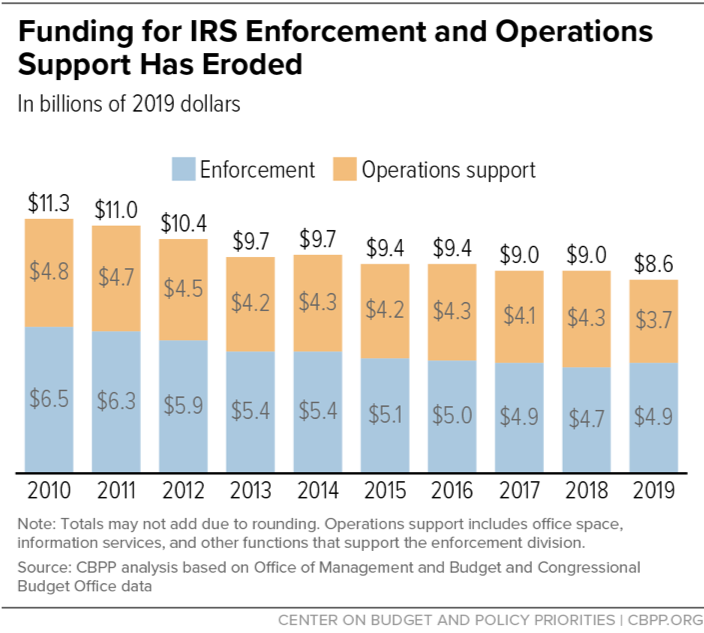- Home
- Federal Tax
- Bipartisan Support For Budget Mechanism ...
Bipartisan Support for Budget Mechanism to Boost IRS Enforcement Is Promising First Step
The U.S. tax system is based on voluntary compliance, which requires a high level of societal trust along with an effective enforcement system, but deep cuts in IRS enforcement funding since 2010 have undermined the agency’s ability to perform this basic function of government. In a promising sign, both the House Budget Committee and the Trump Administration have now proposed a “cap adjustment” to allow added funding for tax enforcement that doesn’t count against the 2011 Budget Control Act’s (BCA) annual caps on non-defense appropriations. Such a mechanism has a long bipartisan history, and policymakers should include it in any budget agreement this year.
Restoring IRS enforcement, however, will also require added funding that does count against the BCA caps, and here the President’s budget falls well short of what’s needed. As the appropriations process — during which the final decisions about overall IRS funding will be decided — moves forward, policymakers should provide sufficient IRS enforcement funding both “inside” and “outside” the BCA caps to put it on a path to return over the next four years to its 2010 inflation-adjusted level.
IRS Enforcement Urgently Needs Funding Restored
The IRS enforcement division’s funding has been cut by one-quarter since 2010, after adjusting for inflation, and has lost fully 31 percent of its workforce since then. IRS enforcement is now so depleted that the agency has only about the same number of revenue agents (auditors who tend to audit the most complex returns) as it had in the 1950s when the economy was roughly one-seventh its current size. The share of returns that the IRS audits has fallen by 40 percent since 2010, and audit rates for high-income people and large corporations are especially low. For example, fewer than 1 in 20 individuals whose income exceeded $1 million were audited in 2017, roughly half the share in 2010. Similarly, the share of the largest corporations (those with at least $20 billion in assets) audited fell from 98 percent in 2010 to 58 percent in 2017.
Even as the enforcement division’s funding and staffing have shrunk, the need for enforcement has grown, due to the 2017 tax law.Even as the enforcement division’s funding and staffing have shrunk, the need for enforcement has grown, due not only to the rising number of taxpayers and increasingly complex global economic and banking systems, but also to the 2017 tax law. The tax law’s design invites taxpayers — particularly affluent individuals and corporations with the means to hire high-priced accountants and lawyers — to push against its boundaries for tax purposes, such as by reclassifying their salaries as “pass-through” income to qualify for the 2017 law’s new pass-through deduction. The IRS must be able to identify those who step over the boundaries.
Proposed Cap Adjustment Would Help
Proposals from both the Trump Administration and House Budget Committee Democrats recognize the special nature of enforcement funding — namely, that it raises significantly more money (in the form of higher tax revenues) than it costs. Both propose that part of IRS enforcement funding not count against the overall Budget Control Act cap on non-defense discretionary funding. The precedents for this approach date back to the bipartisan 1990 Budget Enforcement Act, which included a “cap adjustment” for funding to accommodate certain IRS activities to improve tax compliance. Also, a long-standing cap adjustment allows added funding for certain “program integrity” activities to reduce overpayments and fraud in Social Security, Supplemental Security Income, and Medicare.
Illustrating the potential of such an approach, the Administration estimates that its proposal to provide $14.5 billion over ten years for IRS enforcement outside the BCA caps would generate $47.1 billion in additional revenue over that period, for a net savings of $32.6 billion.[1] This return on investment likely is understated, the Administration notes, because it includes only the revenues directly recovered, not the revenue saved from the deterrence effect that enhanced enforcement would likely have. The Congressional Budget Office’s recent report on deficit-reduction options includes a similar option, estimating that each $1 of additional enforcement funding (once staff training and computer upgrades are completed) would generate $5.20 in additional revenue.[2]
Returning to Real 2010 Funding Level Would Mark Important Step
Rebuilding IRS enforcement will require a multi-year funding commitment because the IRS must hire and train a significant number of auditors and other staff, which requires time and some funding certainty. A reasonable initial goal would be to return to the inflation-adjusted 2010 level over four years. To meet that goal, policymakers must provide not only additional IRS funding outside the BCA caps as explained above, but also some additional funding inside the caps, as explained below.
The relevant budget accounts for IRS enforcement are the enforcement account itself and the operations support account, which includes office space, information services, and other functions that support the division. The enforcement account fell by 25 percent between 2010 and 2019, after adjusting for inflation, from $6.5 billion to $4.9 billion. Operations support fell by 22 percent, from $4.8 billion to $3.7 billion. These figures are in 2019 dollars. (See Figure 1.)
To return to the 2010 inflation-adjusted levels by 2023, funding would need to rise (relative to the 2019 level) by $970 million per year each year for the next four years, with $575 million going for enforcement and $395 million for operations support.
The House Budget Committee proposes cap adjustments of $400 million in 2020 and $750 million in 2021 for the two accounts combined. These amounts would be very helpful, though to return to the 2010 funding levels by 2023, additional amounts relative to 2019 — roughly $570 million in 2020 and $1.2 billion in 2021 — would need to be provided inside the caps during the appropriations process.
The President’s budget proposes a similar cap adjustment as the House Budget Committee,[3] but its overall funding level for IRS enforcement is problematic, highlighting the challenge of providing sufficient funds for IRS both inside and outside the caps. Specifically, the Trump budget’s total funding for the IRS enforcement account in 2020 is effectively flat relative to 2019. It provides $4.7 billion inside the 2020 budget cap, which is below the 2019 enacted level, and $200 million outside the cap through the cap adjustment. As a result, its total funding for the IRS enforcement account is just $45 million above the 2019 enacted level, an increase insufficient even to keep up with inflation. The Administration’s budget proposal consequently would dig the funding hole deeper for the enforcement account instead of putting it on a path to undo the damage from the budget cuts it has endured since 2010. In contrast, the President’s budget does propose sufficient overall funding in 2020 — including the cap adjustment amount — to place the operations support account on a path to return real funding to the 2010 level.
Congress should place a high priority on funding IRS enforcement — both the enforcement and operations support accounts. Even if funding is available outside the caps, adequate funding within the caps will also be crucial. And, to avoid the deep cuts that the BCA sequestration caps would otherwise require in discretionary programs and provide sufficient room under the caps to fund IRS enforcement (and other key areas) adequately, the President and Congress will need to reach a bipartisan agreement in coming months to raise the BCA caps for 2020 and 2021.
End Notes
[1] Internal Revenue Service Congressional Budget Justification, Fiscal Year 2020, https://home.treasury.gov/system/files/266/02.-IRS-FY-2020-CJ.pdf.
[2] Congressional Budget Office, “Options for Reducing the Deficit: 2019-2028,” December 2018, https://www.cbo.gov/system/files/2018-12/54667-budgetoptions.pdf.
[3] The Administration’s cap adjustment proposal applies to the ten years covered in its budget. It proposes $362 million in 2020 outside the caps ($200 million for enforcement and $162 million for operations support) and $749 million in 2021 (with no breakdown between the accounts provided).
More from the Authors


